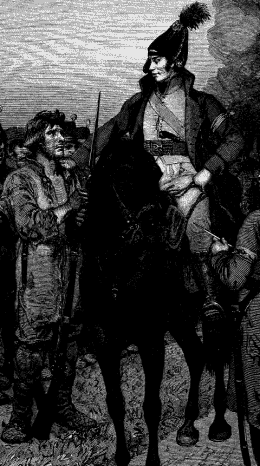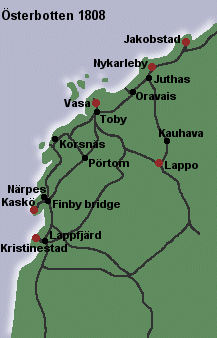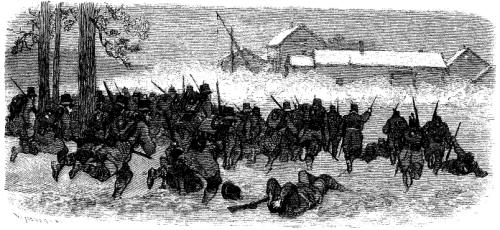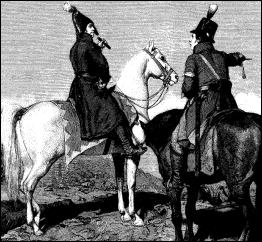The Small War
"The Emperor hereby declares to all European powers, that He from this moment on considers the part of Finland, that up until now has been in Swedish possession, a through the force of His weapons conquered province, that He forever joins with His Empire"
When the Russian Czar invaded Finland in 1808, his main priority was to keep the Finnish people calm. Although some disturbances, the Russian policy of pacification was quite successful as the Czar certainly did not want a Guerilla like the Spanish one at his hands. If the Swedish army had understood the value of threatening the Russian armies in their back, cut their fragile supplylines and worked with the local population where rebellions against the invaders actually took place, the course of the war and the result of it, would have been much different. Let us take a look at the peasant rebellions that took place and also study the operations where the Swedish army successfully executed "commando" operations behind enemy lines. I have three quite interesting examples for you, each one of them from a different theater of the war. Let us take a look at The Small War.
On February 21, the Russian invasion of Finland started as the armies crossed the border. On the 18th and 22nd of that month, the Russian commander Friedrich Wilhelm von Buxhoevden signed a proclamation to the people of Finland with the following meanings: The Russian armies came as friends and not as enemies and all the pain of war was to be avoided as well as it could be, the Czar offered Finland his protection and good will, everyone was told to calmly stay in their homes, the leaders of the community were to remain at their posts and they got to keep them as well during the new rule, all rights and freedoms of the people were to remain, every soldier who left the ranks of the enemy army  was to receive one Rubel and be allowed to return home, for an officer's sabre one Rubel was offered and for a horse ten; the ones who took up arms against the Russian armies would be peronally responsible for the consequences (Source; Duncker och Savolaxbrigaden, p. 30). The response to this proclamation was at best very low, yet the ruling classes within society, education and the church were more easily turned over to the Russian side. Among the Finnish peasants the ancient loyalty to the Swedish king was still very strong, something the Swedish armies would come to depend on.
was to receive one Rubel and be allowed to return home, for an officer's sabre one Rubel was offered and for a horse ten; the ones who took up arms against the Russian armies would be peronally responsible for the consequences (Source; Duncker och Savolaxbrigaden, p. 30). The response to this proclamation was at best very low, yet the ruling classes within society, education and the church were more easily turned over to the Russian side. Among the Finnish peasants the ancient loyalty to the Swedish king was still very strong, something the Swedish armies would come to depend on.
The Summer of War 1808
In the summer and early fall of 1808 the war was to be decided in Österbotten province along the Finnish West Coast. It was here that the main armies operated. Adlercreutz and his main Swedish army was this summer on a counteroffensive that took it deep back into Österbotten. Since Siikajoki and Revolax, the Swedes were slowly regaining lost territory; and famous victories were won, such as the one at Lappo. The operations could only delay the inevitable though, as insufficient reinforcements arrived from Mother Sweden, while Mother Russia continually filled her own ranks with fresh troops. A few badly planned landings of Swedish troops on the coast of Finland were done though. In the Swedish high command it was planned that these landings would also be an all-out signal to rebellion, against the occupation, among the peasants in the areas affected. At one point this actually happened, while the landing itself ended in bloody failure.
The Northern mid-summer festivities were going on in all of Österbotten. And this day, June 24 1808, Swedish troops - about 1000 men - under the command of Johan Bergenstråhle came ashore at Vasa. The Swedish main army stood at Nykarleby in the north, but was apparently too busy partying and celebrating that they had thrown out the Russians from that town, to come to Bergenstråhle's assistance. This was all too bad for him, because when he attacked Vasa, he stood alone against a superior enemy. After heavy fighting in the streets, Bergenstråhle had to give in on the 26th of June. He himself was captured and only 500 of his soldiers were able to escape north to Nykarleby; and Vasa stood a brutal revenge by the Russian troops.
But while all this was happening, captain Fredrik Ridderhjerta of Västerbottens regiment had a totally other mission. He came with 50 soldiers from Jämtland aboard a small boat to the coast just outside Vasa. His orders were to build up the support of the peasants on the islands there.
Beginning on the 23rd of June Ridderhjerta and his officer lieutenant Jakobsson began their operation at Korsö in the Vasa coastal region. There they received the support of 13 of the peasants who were armed with hunting rifles. These got to follow lieutenant Jakobsson and 30 soldiers ashore where about 35 Russians were then captured. On the 25th, Ridderhjerta and his troop, reinforced with more to the Swedish Crown loyal locals, met up with Jakobsson outside Vasa, where he had ordered his small force to entrench. The shooting from Vasa was heard, but to come to the aid of Bergenstråhle was not to think about, since it was told that a garrison of 900 Russians were at Toby, just south of the city. While this was happening, the news of the Swedish landing had already spread among the locals south of Vasa and a full rebellion against the Russians was building up.
On June 26, the peasants in Pörtom attacked a Russian transport, taking all Russians prisoners, in Övermark a similar uprising failed and four of the peasants were killed. But now the peasants "main army" that was marching along the main road south from Vasa, were taking one Russian post after the other; at Korsnäs, Harrström, Töjby, Norrnäs and Nempnäs. The rebellion raged on in full power. All of the area between Vasa and Kristinestad was in full flame. On June 27 the peasants army that now counted 400 men, was able to beat off an attack by some twenty cossacks of the Czar's Elite Lifeguard unit!
 After Bergenstråhle's defeat at Vasa, Ridderhjerta, who was with his peasants at Toby received orders from Klingspor, to immediately evacuate with his regular soldiers to the north to Nykarleby. Yet, he refused to follow orders and stayed on with his peasant army. At the very end of June, the Russians finally evacuated Vasa and the peasant army was the first to liberate that city.
After Bergenstråhle's defeat at Vasa, Ridderhjerta, who was with his peasants at Toby received orders from Klingspor, to immediately evacuate with his regular soldiers to the north to Nykarleby. Yet, he refused to follow orders and stayed on with his peasant army. At the very end of June, the Russians finally evacuated Vasa and the peasant army was the first to liberate that city.
On July 20 one of the strangest battles of the entire war occured. The peasant army had entrenched itself at the bridge at Finby, near the village of Närpes in southern Österbotten. The first shots in the battle were fired in the morning fog as the Russians came along to force out the entrenched peasants. The fighting continued all morning, while Ridderhjerta himself went away to get the assistance of regular troops that were expected in the area. A company of Österbottens regiment soon arrived at the scene, formed line and supported by the peasants they drove the Russians back into Närpes under heavy fighting. The battle ended in victory for the Swedish and Finnish, yet the village of Närpes was to large extent ruined; houses were still burning. The Russian armies returned south.
In late July the peasants army was disbanded as the harvest awaited.
Rebellion on Åland islands
By the beginning of April of 1808 Russian troops had already conquered the Åland Islands. The Swedish troops on the other side were preparing for the defense of Stockholm and the Russians actually planned an invasion from Åland as well (Over 10.000 troops were to be landed at Stockholm according to the plans).
In the first days of May the Russian commander on Åland, Major Paul Nejhardt, feared for the safety of his troops though. The ice was already breaking in the warm spring, threatening to cut his detachement off from the mainland, and the Swedish navy could appear on the horizon any day. He therefore ordered boats to be built by the local citizens on Åland for his troops to use. The Russians had threatened "to cut noses and ears" if the boats were not ready on time. Feelings were going hot among the locals and everyone knew that at the first sight of Swedish troops, there would be a rising against the Russian occupation. The representatives of the establishment tried in vain to calm the hot feelings.
In the evening of May 6, the locals of Åland had had enough of the new rule and under the leadership of Erik Arén, a peasant and Gummerus, priest (who was not very popular among colleagues as he was considered to "live an unordered life"), they formed a small troop to throw the Russians out. The plan was to go directly to Strömsvik where Paul Nejhardt and thirteen cossacks were and there arrest them. 100 men from Finström gathered and equipped themselves with hunting rifles, clubs and other primitive weapons; boats were sent out to sea to prevent the Russians from escaping. In the evening at 9 o'clock, Nejhardt received the message that the peasants rebellion was in full progress. And so, when the rebels finally came to Strömsvik, he had already left. During the night the rebellion spread over all of Åland and small parties of rebels started moving. At the ferry that linked the two main parts of the Åland Islands a cossack was killed in a first skirmish and the ferry conquered by the rebels. Major Paul Nejhardt himself rode into a trap but was able to escape, while two of his cossacks were killed. Within ten hours eighty Russians had been captured, some after giving resistance. No peasants had been injured in the action and the mutiny had grown to about 150 rebel locals.
On May 7, the "battle of Toftö" was fought, which saw the 150 peasants storm against a Russian force under loud Hurrahs. This action saw 130 Russian soldiers and 6 cossacks be captured. That evening the locals of Åland partied and even the captured Russian soldiers took part in the festivities with songs and drums. Paul Nejhardt, the great hero from Friedland, who had been wandering around in the woods on Åland volontarily surrendered himself, starved and exhausted, to the rebels and was sent over to mainland Sweden and there surrendered his sword. "I have decided to give this sword only to an officer", he said.
In cooperation with regular a squadron of regular Swedish troops under Lieutenant Kapfelman, the peasant army then went on to attack a larger Russian force of about 600 men surrounded on the island of Kumlinge. The Russian commander Colonel Vuitj was having dinner as the battle began, but did not take too much notice until an artillery salvo shattered a chimney on a nearby house. Believeing that he was pitched against a larger invasion of regular troops, Vuitj ran out in the yard with a white sheet on a pole. All the Russians surrendered and 500 along with the colonel himself were captured. The battle of Kumlinge on May 10 was a total victory, crowning the "war of liberation".
The following year, this notice was printed in Robert K Porter's Travelling Sketches in Russia and Sweden: "The inhabitants of Aland, after enduring the anguish of the bitterest oppression from the Cossacs, eagerly followed the standard held out to them by their spiritual leader; and headed by a dauntless peasant of their own island, they laid the plan for its recovery [...] Several fell on both sides: but the undaunted courage of men fighting for their homes and families prevailed; and the imperial troops, commanded by a field-officer, were taken prisoners." (Source: 1808 Gerillakriget i Finland, p. 79)

The small war in Karelia and the Savolax Brigade
During the Winter War of 1939-40 successful Finnish defenders fought off many times a stronger enemy in fierce surprise attacks. The Finnish used the woods as cover, while the Soviets often came along the roads and were trapped by the innovative Finnish armies. So-called "Motti tactics" were used. The war of 1808-09 in Karelia saw operations of some similarity to these later-day experiences.
When the Swedish retreat ended in counteroffensive after Siikajoki and Revolax, Johan August Sandels with his Savolax Brigade got the mission of liberating the parts of Finland, nearest to the Russian border. Sandels marched of east in the direction of Kuopio with a force numbering 1.431 troops. Sandels was a courageous and brave leader and took the opportunity to make use of all weaknesses in the enemy plans. The first battle in the campaign came at Pulkkila on May 2 1808, where the Russian troops were surrounded and finally, after a four hour battle, had to give up to the advancing Swedish troops. The result of the battle was 40 men dead and 300 captured on the Russian side, while the Swedish lost 10 dead and 50 wounded. On May 12 captain Karl Wilhelm Malm, along with peasants who had risen up against the occupation, retook Kuopio after defeating the Russians and forcing them off in retreat.
 Karl Wilhelm Malm, who was now in charge of the Swedish avantgarde, won some notable successes. With 250 regular soldiers and about 400 armed peasants he executed his attack on a superior enemy. By August 9-10, Malm defeated a Russian force of 1.300 at Pälkjärvi, throwing them back over the national border. He then continued in on Russian territory, occupying the village of Pirttipoja and thereby became the only Swedish officer to occupy Russian territory in this war! This operation was of course not of any military value at all, yet it had its value for the morale.
Karl Wilhelm Malm, who was now in charge of the Swedish avantgarde, won some notable successes. With 250 regular soldiers and about 400 armed peasants he executed his attack on a superior enemy. By August 9-10, Malm defeated a Russian force of 1.300 at Pälkjärvi, throwing them back over the national border. He then continued in on Russian territory, occupying the village of Pirttipoja and thereby became the only Swedish officer to occupy Russian territory in this war! This operation was of course not of any military value at all, yet it had its value for the morale.
While all this was happening in the east, Sandels stood with his brigade at Toivola further north. Here he was entrenched and fended off almost daily Russian attacks. The Russians came in their boats on the lakes, bombarded the Swedish entrenchements and made landing attempts. As long as the Swedish had the upper hand at sea, the Russians could not do much, but by the end of July the superiority on the lakes fell over to the Russian side. The Swedish troops entrenched at Toivola slept in their uniforms night after night, to not be surprised by sudden enemy attacks. The conditions must have been appalling. Sandels defended his Toivola front for three months.
On September 30 the Russian troops took the Swedish trenches at Toivola, while Sandels retreated north to take up positions at Virta, where later he won his famous victory. Sandels was according to the Russian high command "The best of the generals who were acting against us".
The Swedish high command never fully realized the potential of the people's uprisings that did occur during the war. Had they been better used, and regular troops used to support and maintain the rebels, the result of the campaign could have been much different. As it stands, the uprisings only demonstrated the fear that the common people had for the Czar and his regime; they even feared that they would now become serfs. The uprisings also demonstrated the ancient love the Finnish people felt for the Swedish king and his legal government. The result of the war showed clearly that the fear for the Czar's regime was largely unfounded. Finland became an autonomous region of a large empire and the Czar rather wanted a peaceful Finland, than an aggressive one, as he saw the great war against Napoleon coming on. And Finland stayed calm during the Great Patriotic War.
Back to Articles Archive
© Göran Frilund 2000-03, All Rights Reserved.
If you've surfed onto this page from outside and there is no menu on the left,
CLICK HERE for the full Website.

 was to receive one Rubel and be allowed to return home, for an officer's sabre one Rubel was offered and for a horse ten; the ones who took up arms against the Russian armies would be peronally responsible for the consequences (Source; Duncker och Savolaxbrigaden, p. 30). The response to this proclamation was at best very low, yet the ruling classes within society, education and the church were more easily turned over to the Russian side. Among the Finnish peasants the ancient loyalty to the Swedish king was still very strong, something the Swedish armies would come to depend on.
was to receive one Rubel and be allowed to return home, for an officer's sabre one Rubel was offered and for a horse ten; the ones who took up arms against the Russian armies would be peronally responsible for the consequences (Source; Duncker och Savolaxbrigaden, p. 30). The response to this proclamation was at best very low, yet the ruling classes within society, education and the church were more easily turned over to the Russian side. Among the Finnish peasants the ancient loyalty to the Swedish king was still very strong, something the Swedish armies would come to depend on. After Bergenstråhle's defeat at Vasa, Ridderhjerta, who was with his peasants at Toby received orders from Klingspor, to immediately evacuate with his regular soldiers to the north to Nykarleby. Yet, he refused to follow orders and stayed on with his peasant army. At the very end of June, the Russians finally evacuated Vasa and the peasant army was the first to liberate that city.
After Bergenstråhle's defeat at Vasa, Ridderhjerta, who was with his peasants at Toby received orders from Klingspor, to immediately evacuate with his regular soldiers to the north to Nykarleby. Yet, he refused to follow orders and stayed on with his peasant army. At the very end of June, the Russians finally evacuated Vasa and the peasant army was the first to liberate that city.
 Karl Wilhelm Malm, who was now in charge of the Swedish avantgarde, won some notable successes. With 250 regular soldiers and about 400 armed peasants he executed his attack on a superior enemy. By August 9-10, Malm defeated a Russian force of 1.300 at Pälkjärvi, throwing them back over the national border. He then continued in on Russian territory, occupying the village of Pirttipoja and thereby became the only Swedish officer to occupy Russian territory in this war! This operation was of course not of any military value at all, yet it had its value for the morale.
Karl Wilhelm Malm, who was now in charge of the Swedish avantgarde, won some notable successes. With 250 regular soldiers and about 400 armed peasants he executed his attack on a superior enemy. By August 9-10, Malm defeated a Russian force of 1.300 at Pälkjärvi, throwing them back over the national border. He then continued in on Russian territory, occupying the village of Pirttipoja and thereby became the only Swedish officer to occupy Russian territory in this war! This operation was of course not of any military value at all, yet it had its value for the morale.